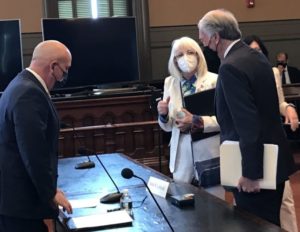PLYMOUTH — The president of Holtec International, the company decommissioning the Pilgrim Nuclear Power Station, has pledged not to release radioactive water from the reactor into Cape Cod Bay without the consent of “stakeholders,” including the Mass. attorney general.
After being pressed by U.S. Sen. Ed Markey during a Congressional hearing here on May 6, Kris Singh also said his company would allow an independent study of the water by marine life experts.
Markey asked Singh to allow testing of the water by an independent lab such as the Woods Hole Oceanographic Institution (WHOI) and to “not release the water until it is confirmed safe.”
“We will share with them any information we have and give them access to the data at the plant,” Singh said.
“We’ll take you at your word,” the senator responded.
Holtec’s president added, “If it shows the water is not contaminated, I hope the release will be reinstated.” He got no response to that comment.
After the hearing, Markey said, “We have to make sure the commitments made today are made in writing.”
Holtec announced in late November that it planned to release one million gallons of radioactive water from the plant’s spent fuel pool, reactor cavity, and other systems. Following an outcry from the region’s state and federal legislators, municipal officials, fishing and shellfishing organizations, advocates for the tourism and real estate industries, and the public, Holtec pledged not to release any water in 2022 while it looked at options.

The company could ship the water offsite to a licensed disposal facility or use evaporation technology to dispose of it. But Holtec has consistently noted the downsides of those alternatives and refused to take the release into Cape Cod Bay off the table.
Friday’s hearing, held by the Environment and Public Works Subcommittee on Clean Air, Climate and Nuclear Safety, was chaired by Sen. Markey. He and U.S. Rep. Bill Keating grilled John Lubinski, director of the Nuclear Regulatory Commission’s Office of Nuclear Material Safety and Safeguards, on the agency’s current lack of strict regulations on the nuclear industry and on changes they see as weakening the rules even further.
Discussion always came back to the proposed release of the radioactive water.
When Keating asked Lubinski why Holtec couldn’t truck the radioactive water away, he was told, “It is up to them,” meaning Holtec.
“We just don’t agree with ‘It’s up to them,’ ” Keating responded.
To a suggestion that the water be stored onsite, Singh said that would delay completion of decommissioning.
In a letter sent to Markey on Monday, he put the company’s commitment to work with an expert in writing.
“We will voluntarily refrain from releasing processed water to the bay even if lawfully permitted by the authorities (EPA and NRC) until the processed water discharge is confirmed by your expert’s determination to contain radiological levels low enough to ensure that the local marine life remains protected,” Singh wrote.
Singh added that Holtec will “hold the processed water inside the plant for as long as necessary if expert scientific opinion advises against discharging the remaining plant water into the bay.”
Diane Turco, director of the anti-nuclear Cape Downwinders, was distrustful of Singh’s statements during the hearing.
“Holtec needs to be held accountable to do what they said they were going to do,” Turco said. “The stakeholders have already said they don’t want the water dumped into the bay, so they should be taking that off the table and working on other plans.”
Ken Buesseler, a marine radiochemist at WHOI, said his institution would not be able to test the radioactive water. “A concentrated brew of radioactive isotopes would contaminate the whole lab,” he said. “We’re not set up to do that.”
There are other labs that come to contaminated sites to conduct tests; Buesseler said it was “essential” that the testing be done well and independently.
“I’d be happy to advise people what to test for,” Buesseler said. “My suspicion is it’s a mix of radionuclides of varying health concerns. For example, this form of cobalt-60 is likely to end up on the sea floor.”
WHOI could test the bay water before, during, and after the release, if it occurs.
Buesseler called Holtec’s commitment to independent testing “a first step and positive sign.” But he warned, “You need some assurance they don’t take the sample out of a rain barrel.”



